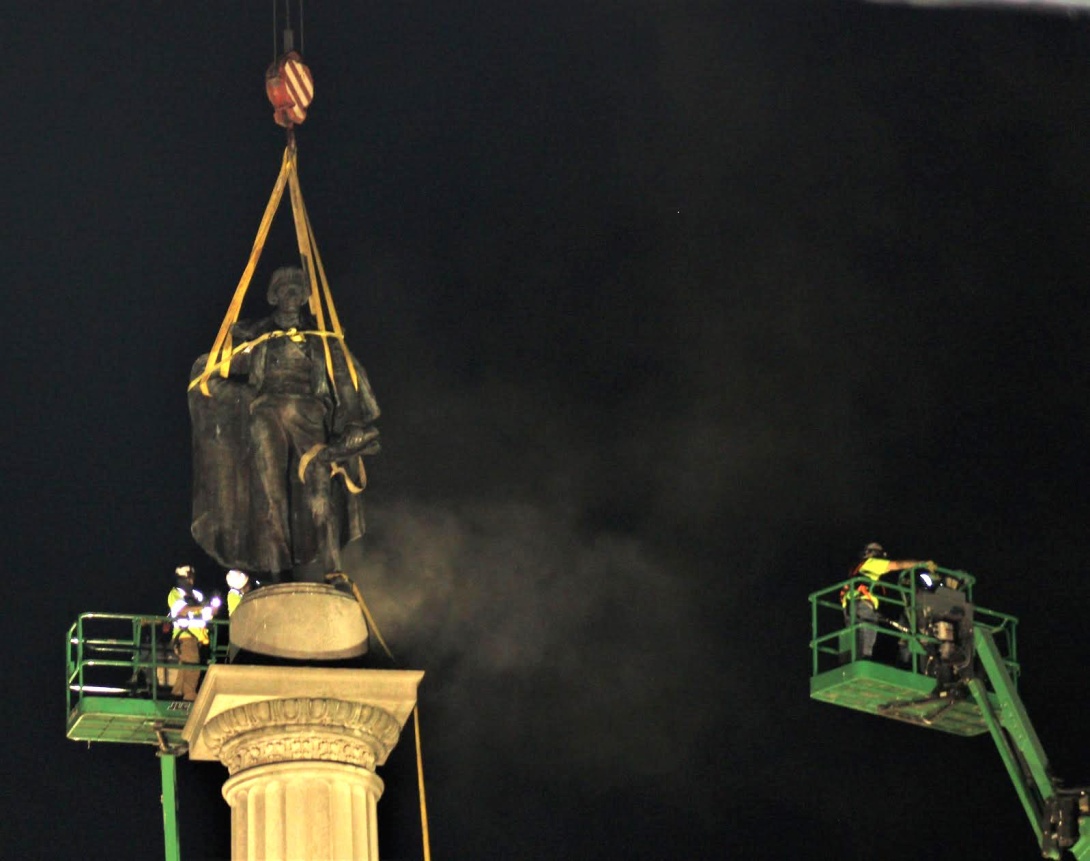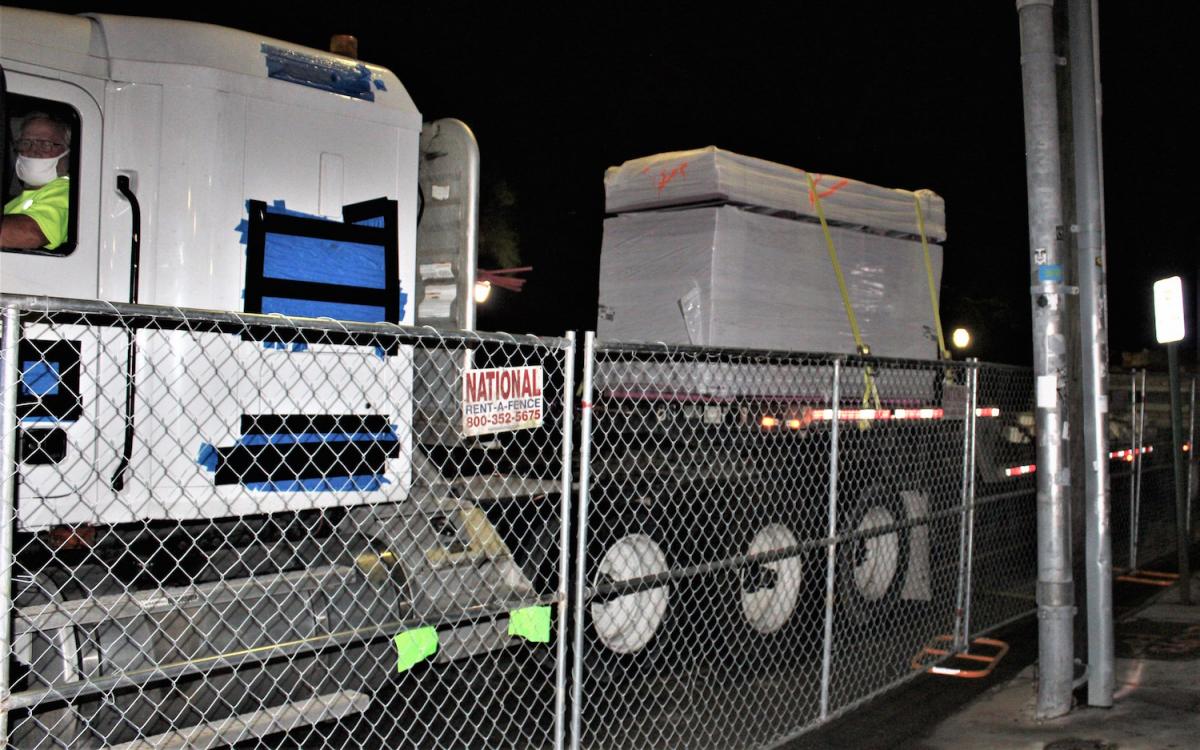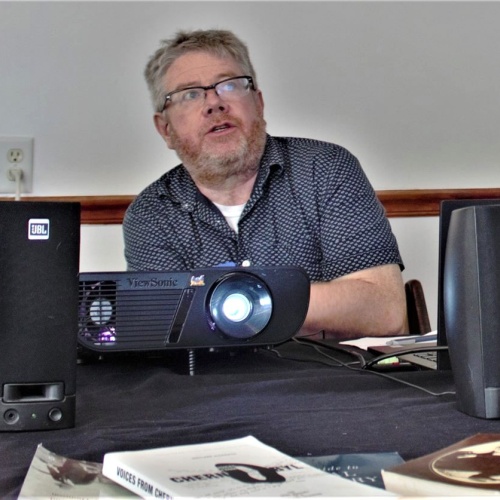Charleston's deposed Calhoun monument and the erasure of Black workers

The Calhoun monument has been removed from a public square in downtown Charleston, but the fact that the work was done by what appeared to be an all-white crew of about 40 men points to contradictions that define our political moment. (Photo by Kerry Taylor.)
In 1896, Black workers in Charleston, South Carolina, erected a 115-foot-tall monument to John C. Calhoun, the former U.S. vice president, vigorous defender of slavery, and political theoretician who provided much of the ideological foundation for secession. On June 24, 2020, a white work crew removed the monument from downtown's Marion Square.
Even as Charleston city and community leaders celebrate the Calhoun statue's removal as a mark of racial progress, the erasure of black labor from many occupations in the region is an unsettling reminder of the failures of civil rights reform.
The Calhoun monument has been a flashpoint for controversy from its beginnings, according to historians Blain Roberts and Ethan Kytle. Calls to remove or modify the monument intensified following the April 2015 police murder of African American motorist Walter Scott in North Charleston and the June 2015 racist massacre at Charleston's Mother Emanuel AME Church, which sits less than a block away from Marion Square. City officials debated Calhoun's future but failed to act even as the Confederate flag was removed from the State House grounds in July of 2015.
The debates were revived following the May 25 Minneapolis police killing of George Floyd and took on greater urgency when the national protest wave hit Charleston. On May 30, a mass march in the downtown area was followed by an outbreak of window breaking and theft concentrated on King Street shops and restaurants. Police used tear gas and pepper spray to disperse protesters. They arrested dozens that evening on a variety of charges and have continued to make arrests at subsequent demonstrations. Last week, seven adults and two minors were arrested after they painted and decorated the base of the Calhoun statue. Business owners have complained of police inaction as protesters, activists, and civil libertarians have charged the police with using excessive force.

For city council members, the disruptions proved clarifying. On June 23, they voted unanimously to remove the statue, and a few hours later workers arrived in Marion Square to commence the unexpectedly long and difficult separation of Calhoun from his pedestal. As of this writing, little is known about the workers who carried out the removal. To ensure anonymity, they used heavy tape to conceal their employers' name and other identifying markers on their work clothes and on the convoy of company trucks and cranes. The city has not responded to requests to reveal details of the removal contract, including the contractor's identity. From the square on Calhoun Street, I was unable to identify a single non-white worker from among the crew of about 40. Nor did any appear to me to be women.
They did appear to be highly skilled, careful, and efficient. They chatted amiably with the diverse group of spectators, nearly all of whom were there to welcome the statue's removal. Most worked in support roles, securing and lighting the worksite and stabilizing the three overhead cranes. From their crane baskets, two teams of two workers each worked high above the square to secure the statue and cut through bronze and stone. As their diamond band saws engaged metal, fire and smoke spewed forth from Calhoun's feet, appearing as a final act of defiance that magnified his mythic and monstrous manifestation.
Shortly after 5 p.m., Calhoun was returned to the ground again after nearly 124 years.
Erasures historic and contemporary
We know little more about the workers who raised the Calhoun monument in 1896 to replace an earlier monument to the man that was derided on aesthetic grounds. The historic records are spare. They were employed by an Irish-born contractor, Daniel A. J. Sullivan, a carpenter by trade who became a prominent builder in Charleston after the Civil War. He was active in the local Democratic Party and served in the state legislature.
The kind of work required for the Calhoun project relied heavily on large crews of carpenters, masons, draymen and teamsters, and general laborers. Data compiled by historian Bernard Powers indicates that African American workers at the time constituted 76% of Charleston's carpenters, 85% of its brick and stone masons, 90% of its draymen, and 87% of its laborers.
Maybe the best clue as to the race of the workforce comes to us from a Feb. 15, 1896, news item published in the Charleston Evening Post that mentions "the working men who are engaged on the Calhoun Monument." Using racist vernacular, the author surmised that the they were likely amused by the discarded earlier statues of "Mr. Calhoun and 'ee wife," referring to the bronze woman who symbolized "justice" on the monument.
The vanishing of black workers from the historical record is a familiar challenge for scholars of African American history and genealogists. Their absence from the Charleston work crew in 2020 is inexcusable and points to contradictions that define our political moment. Symbols of racism, including statues, flags, and place names are being scrutinized and dispatched by businesses, colleges, and government institutions, from NASCAR to the U.S. House of Representatives. Institutional leaders like the Spanish-born CEO of PepsiCo, Ramon Laguarta, have taken steps to rebrand their companies and their products, and have pledged resources to "help dismantle the systemic racial barriers that for generations have blocked social and economic progress for Black people in this country."
Black victories in the areas of police reform, voting rights, jobs, wages, and health care — the scaffolding of systemic racism — will be more elusive. Nevertheless, as Ajamu Dillahunt, a member of the Southern Workers Assembly steering committee and a former local president of the American Postal Workers Union, has observed, the "interrelated pandemics" have created new organizing opportunities. The crises have highlighted "the fact that all workers are essential to capitalism not just during a crisis, but every day," he noted, and have given rise to a bolder willingness of young people and workers to take action to realize their demands.
The removal of racist symbols represents our judgment on the past, but the standard by which we will be judged is higher, according to the Rev. William Barber, the national co-chair of the Poor People's Campaign: A National Call for a Moral Revival. "There certainly is a place for the statues to come down," Barber recently told The News and Observer of Raleigh, North Carolina. "But we have got to change the statutes."
Tags
Kerry Taylor
Kerry Taylor is a board member of the Institute for Southern Studies, the nonprofit that publishes Facing South, and directs the Charleston Oral History Program at the Citadel: The Military College of South Carolina.
